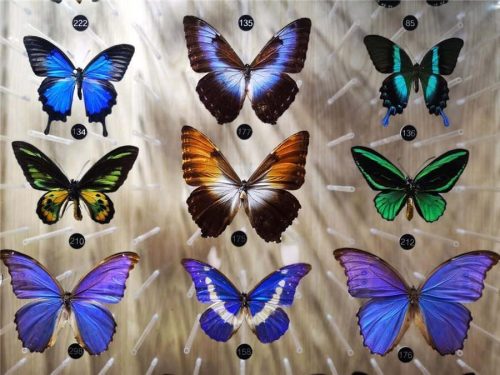A Different Perspective Brings a Different Colour
Fields covered: Structural Colour, Optics, Butterflies, Physics
Related Articles:
§ ![]() The evolution of structural colour in butterflies §
The evolution of structural colour in butterflies § ![]() Structural color in Junonia butterflies evolves by tuning scale lamina thickness §
Structural color in Junonia butterflies evolves by tuning scale lamina thickness § ![]() Signal design and courtship presentation coincide for highly biased delivery of an iridescent butterfly mating signal |
Signal design and courtship presentation coincide for highly biased delivery of an iridescent butterfly mating signal |
The most vivid colours in nature can be found in butterflies with their beautiful wing patterns. Like a digital image made up of differently coloured pixels, butterfly wings are layered with tiny, coloured scales invisible to the naked eye. Each scale has its own colour, and thousands of them form the final pattern on the butterfly wing. These scales can generate colour via two methods: pigmentary or structural. Pigmentary colour, as its name suggests, produces colour via pigments, while structural colour generates colour by scale colours scattering light.

Butterfly scales aren’t flat. They contain a variety of chitin nano-scale structures capable of scattering light. As light passes through the scales, some will be scattered in a specific wavelength as determined by the scale structure. The wavelength of the light determines the colour that we see, and butterflies typically scatter light in the ultraviolet and visible light range. We can see light in the visible light range, while butterflies can see into the ultraviolet range. The simplest form of structure producing colour in butterflies is the lower lamina, which is a thin layer of chitin on the bottom of the scale. The thickness of the lower lamina determines the final colour produced, and because this thickness can be tuned easily, butterflies can evolve new structural colours very quickly.

Structural colour relies heavily on the angle of light passing through the scale. This means that if you observe a blue butterfly from two different angles, you will see two colours. Such a phenomenon is termed iridescence (see video for iridescence). Iridescence is a by-produce of structural colour, and yet it can be extremely useful in solving the dilemma of bright colours. For butterflies, bright colours would attract mates and predators, making it a double-edged sword. To solve this, some butterflies use iridescence that only shows bright colours under a specific angle. Only when the butterflies see potential mates, they will pose themselves to show the bright iridescent colour, allowing the butterfly to be brightly visible to mates but not to predators. This leads to one extremely important function of structural colours: for finding mates.
Example of Iridescence on Butterflies: https://www.youtube.com/watch?v=29Ts7CsJDpg




